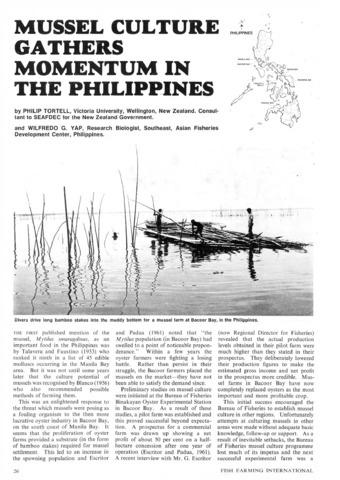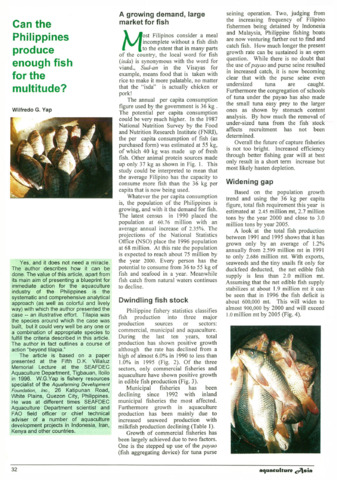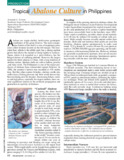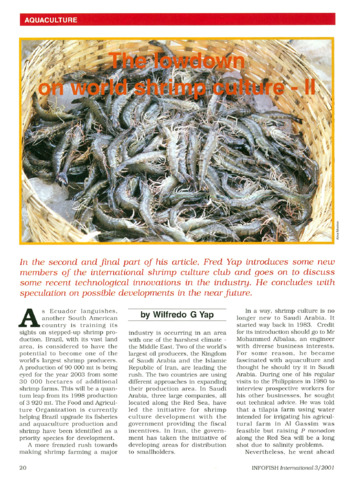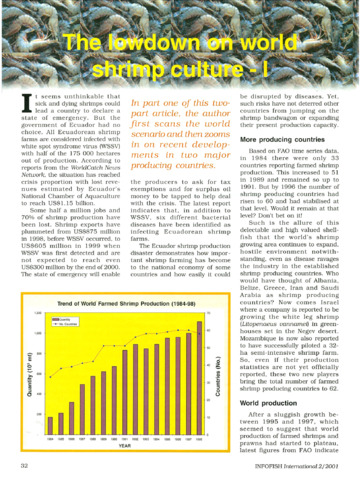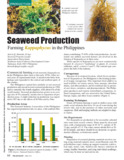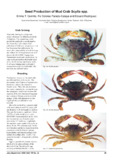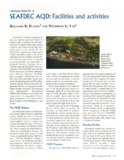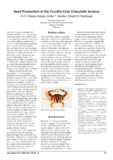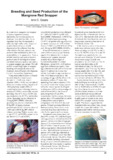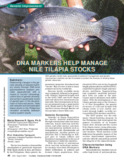公開日 のブラウズ: Magazine and Newsletter Articles by SEAFDEC/AQD Staff
1-20 / 61
-
Mussel culture gathers momentum in the Philippines
(Arthur J. Heighway Publications Ltd., 1976-12)Mussels (Mytilus smaragdinus) were posing a threat as fouling organisms in Bacoor Bay, on the south coast of Manila Bay but when attempts were made to market the mussel so much success was achieved that attempts to culture ... -
Breeding marine aquarium animals: The anemonefish
(International Center for Living Aquatic Resources Management, 1989-07)A brief account is given of experiments undertaken regarding the breeding of anemonefish (Amphiprion), a species popular among marine aquarists. Findings indicate these fish to be good candidates for reproductive physiology ... -
Oyster and mussel farming in Western Visayas, Philippines
(International Center for Living Aquatic Resources Management, 1992)The slipper oyster (talaba) and the green mussel (tahong) are the only mollusc species farmed in the Philippines. They are farmed for their meat, and consumption is mainly for the domestic market. The Western Visayas region, ... -
Economic assessment of shrimp (Penaeus monodon) hatchery industry in Panay Island, Philippines
(International Center for Living Aquatic Resources Management, 1994-07)Results of the economic assessment of shrimp hatchery industry in Panay Island, Philippines are presented. In order to ensure continuous viability of hatcheries, the critical areas of concern are: financing of operating ... -
Can the Philippines produce enough fish for the multitude?
(Network of Aquaculture Centres in Asia-Pacific (NACA), 1997)Philippine fishery statistics classified fish production into 3 major production sources: commercial, municipal and aquaculture. Of these, only commercial fisheries and aquaculture have shown positive growth; municipal ... -
Tropical abalone culture in Philippines
(Global Aquaculture Alliance, 2001) -
The lowdown on world shrimp culture - II
(INFOFISH, 2001)This paper introduces some new members of the international shrimp culture club and goes on to discuss some recent technological innovations in the industry, particularly the polyculture of tilapia (mainly Oreochromis ... -
The lowdown on world shrimp culture - I
(INFOFISH, 2001)Based on FAO time series data, in 1984 there were only 33 countries reporting farmed shrimp production. This increased to 51 in 1989 and rose to 60 in 1996. The world total shrimps and prawns production reached 1.114 million ... -
Seaweed production: Farming Kappaphycus in the Philippines
(Global Aquaculture Alliance, 2002) -
Seed production of mud crab Scylla spp.
(Network of Aquaculture Centers, 2002)Mud crab farming is an important source of income for fish farmers in the Philippines. The expanding export market for mud crab as an alternative for shrimp has led to intensified collection of wild seed for grow-out and ... -
SEAFDEC AQD: Facilities and activities
(World Aquaculture Society, 2002)As an R & D complex in aquaculture that can conduct replicated studies in marine waters, brackish water and freshwater, be it in aquaria, large tanks, earthen ponds or cages, there are not that many institutions in the ... -
Seed production of the crucifix crab Charybdis feriatus
(Network of Aquaculture Centers, 2002) -
Breeding and seed production of the mangrove red snapper
(Network of Aquaculture Centers, 2002) -
Retaining our mangrove greenbelt: Integrating mangroves and aquaculture
(Secretariat, Southeast Asian Fisheries Development Center, 2004)Although multilateral agencies in Southeast Asia have long been promoting that mangroves, and other wetlands, are wastelands to be put into better use, such as conversion to ponds. However, there is a need for Mangrove ... -
DNA markers help manage Nile tilapia stocks
(Global Aquaculture Alliance, 2006)Determining changes in the genetic diversity of selected hatchery stocks through DNA-level polymorphisms analysis provides aquaculturists with a means to monitor inbreeding, control loss of genetic diversity, and achieve ... -
Science and environment education: Aquaculture in focus
(Secretariat, Southeast Asian Fisheries Development Center, 2007) -
Towards sustainable aquaculture in the ASEAN region
(Secretariat, Southeast Asian Fisheries Development Center, 2007) -
Mangroves or aquaculture? Why not both?
(Secretariat, Southeast Asian Fisheries Development Center, 2008)This article briefly summarizes the techniques developed, verified and/or refined during the implementation of the Project on the Promotion of Mangrove-Friendly Shrimp Aquaculture in Southeast Asia, which was implemented ... -
The filter net [tangab] fishery in Iloilo Strait, Philippines: Food and livelihood for coastal communities in the midst of waste of non-target fishery resources
(Secretariat, Southeast Asian Fisheries Development Center, 2008)The Philippines is home to a mixed of blessings: an enormous marine biodiversity, a tremendous variety of fishery enterprises, and about 50 million coastal residents who mostly fish and eat fish. So many animals and so ... -
Sustainable tilapia farming: a challenge to rural development
(Secretariat, Southeast Asian Fisheries Development Center, 2008)The availability of improved Nile tilapia strains is a major factor that has opened up new avenues for renewed growth in the tilapia industry especially in the rural sector. This was hailed as a positive development in the ...

